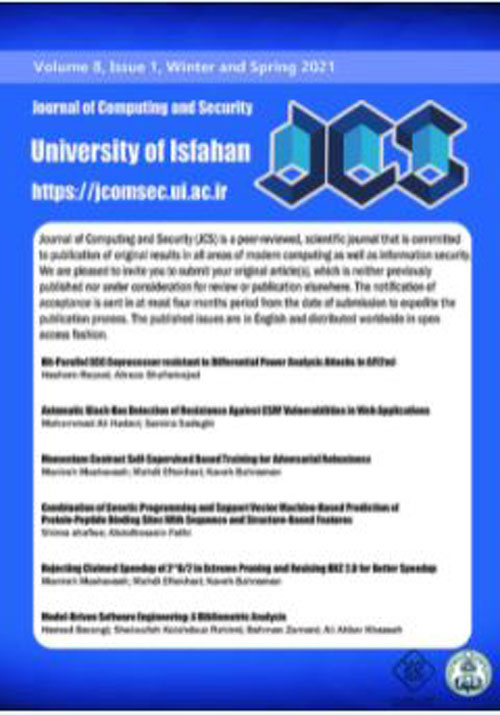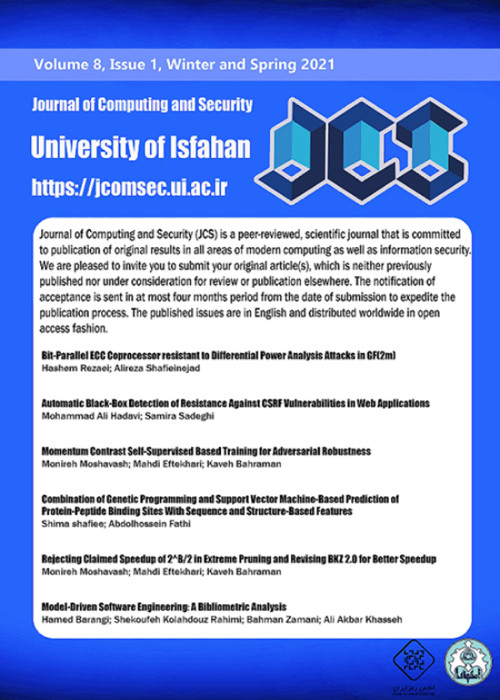فهرست مطالب

Journal of Computing and Security
Volume:8 Issue: 2, Summer and Autumn 2021
- تاریخ انتشار: 1400/10/22
- تعداد عناوین: 4
-
-
Pages 1-18In recent years, Question Answering systems have become more popular and widely used by users. Despite the increasing popularity of these systems, their performance is not even sufficient for textual data and requires further research. These systems consist of several parts that one of them is the Answer Selection component. This component detects the most relevant answer from a list of candidate answers. The methods presented in previous researches have attempted to provide an independent model to undertake the answer-selection task. An independent model cannot comprehend the syntactic and semantic features of questions and answers with a small training dataset. To fill this gap, language models can be employed in implementing the answer selection part. This action enables the model to have a better understanding of the language in order to understand questions and answers better than previous works. In this research, we will present the 'BAS' stands for BERT Answer Selection that uses the BERT language model to comprehend language. The empirical results of applying the model on the TrecQA Raw, TrecQA Clean, and WikiQA datasets demonstrate that using a robust language model such as BERT can enhance the performance. Using a more robust classifier also enhances the effect of the language model on the answer selection component. The results demonstrate that language comprehension is an essential requirement in natural language processing tasks such as answer selection.Keywords: Question Answering, Deep Learning, Answer Selection, Language Modeling
-
Pages 19-26In this paper, we focus to find desired node position in indoor environments using a sequence of observations and user movement records. For this purpose, we first record the user's movements in indoor environments by defining a set of states and several matrices, which are Viterbi inputs. To record the fingerprints of the environment, we move across the entire coordinates of the building to collect and record the fingerprints of different places. In the online phase, we use the Weighted K-Nearest Neighbors (WKNN) algorithm in parallel to check the accuracy of both WKNN and Viterbi algorithms and to correct the WKNN behavior by Viterbi. During this phase, an experimental node is inserted into the environment and moves in the desired direction by determining the destination. The proposed method calculates the current location of the node and its most probable location in the next step. The results of the implementation and testing of the proposed algorithm in the Faculty of Engineering, Arak University, show the optimal performance of the proposed idea for predicting the location and path of the node.Keywords: Indoor Localization, Observation Sequence, Most Probable Path, Viterbi
-
Pages 27-42Due to the increasing development and applications of the Internet of Things (IoT), detection and prevention of intruders into the network and devices has gained much attention in the past decade. For this challenge, traditional solutions of Intrusion Detection Systems (IDS) are not responsive in IoT environments or at least may not be very efficient. In this article, we deeply investigate the previous methods of using machine learning methods for intrusion detection in IoT, and two methods for feature extraction and classification are proposed. The first method is feature extraction and classification using Logistic Regression (LR) and the second method is to use an Artificial Neural Network (ANN) for classification. To evaluate the performance of the proposed method, six devices of the N_BaIoT dataset, which consists of data samples related to nine devices IoT and several attacks are used according to some criteria for evaluating the performance of the proposed methods. Simulation results in comparison with some other deep learning methods in terms of accuracy, precision, recall and F1-score show that using logistic regression, is more efficient and above 90% classification accuracy is achieved.Keywords: Internet of Thing, Anomaly Detection, artificial neural network, Logistic Regression, Botnet
-
Pages 43-57The scalability of a single gateway LoRa network depends on different parameters such as interference and noise. The scheme of spreading factor allocation can control the interference and noise. This article analyzes the impact of the interference of the concurrent transmission with the same spreading factor (co-SF) and different spreading factor (inter-SF) on the scalability of the LoRa network. The interference has been modeled as the Poisson point process. The proposed scheme considers the success probabilities and device density (SPD) in each area in determining the width and boundaries of SF areas. The simulation results showed that the proposed SPD scheme had improved 13.20% over the EIB method in terms of success probability under joint co-SF and inter-SF interference. Also, the coverage probability under the joint impact of cumulative co-SF and inter-SF interference of the SPD and EIB methods is compared in the clean and noisy conditions. The probability of coverage in EIB degrades more than SPD as the scalability increases. Also, the uplink performance of the proposed SPD scheme has been studied in the absence of any interference under AWGN. SPD has a higher success probability under AWGN than EIB.Keywords: Scalability of LoRa, LoRaWAN, Inter-SF, co-SF Interference, Coverage Probability, Success Probability


